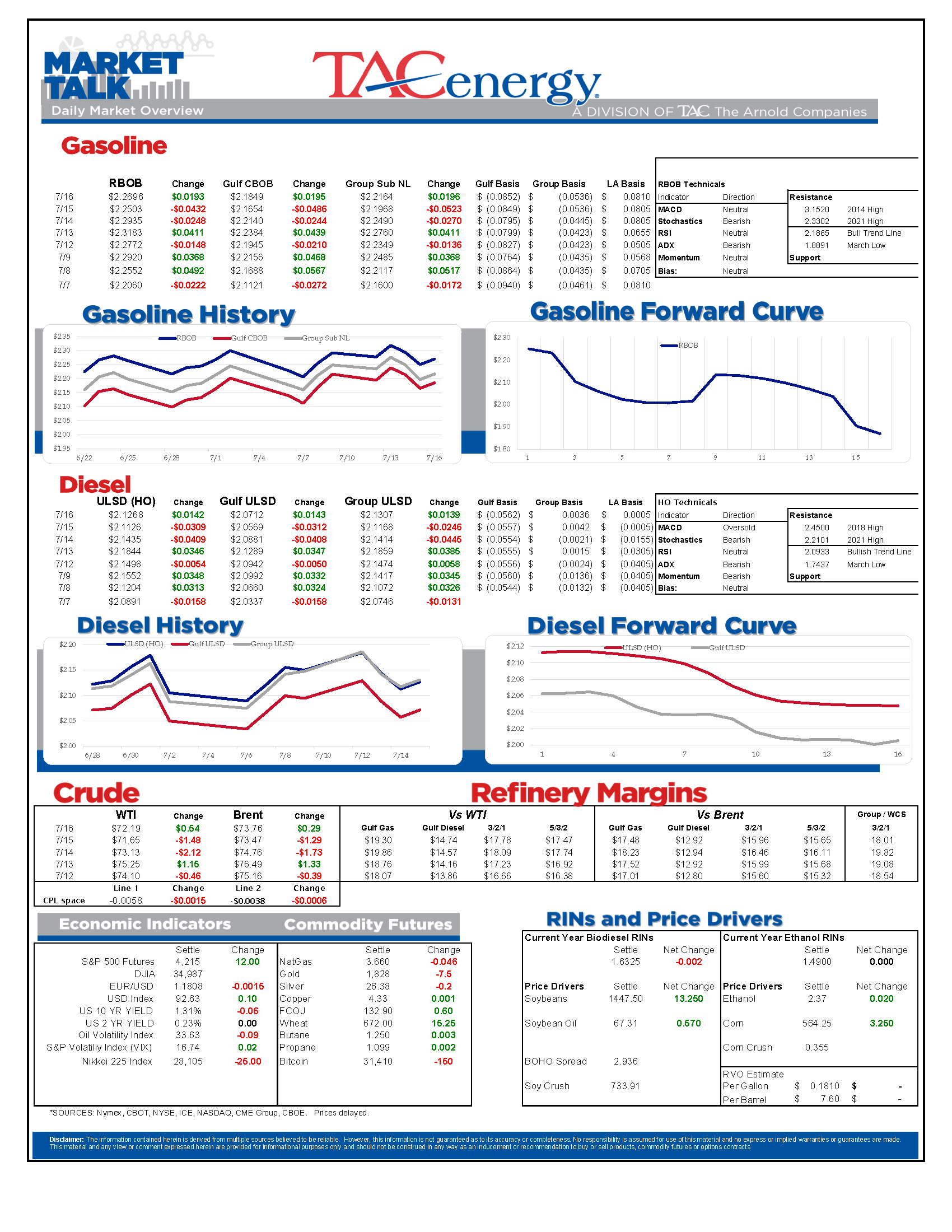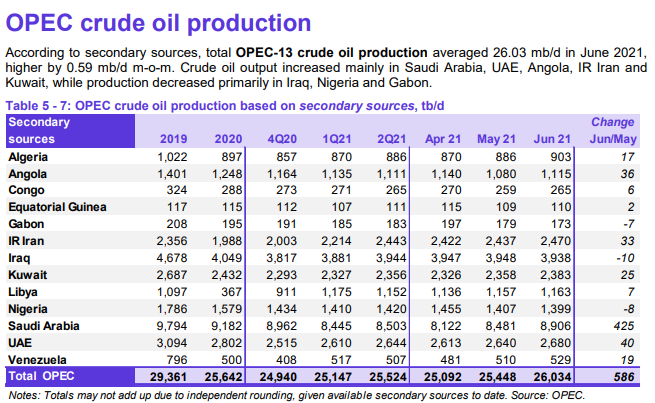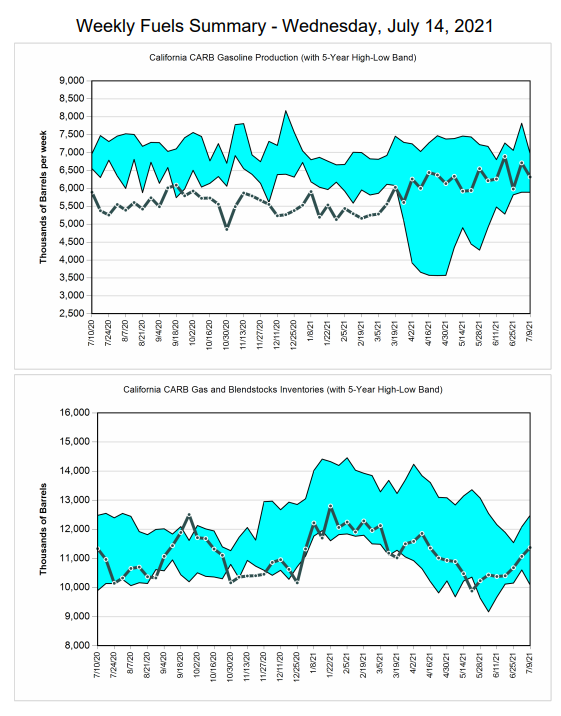Equity And Energy Markets Sent Sharply Lower

Surging COVID case counts, a new OPEC deal, and the risks of a cyber-war between the world’s two largest economies all seem to be combining to send equity and energy markets sharply lower to start the week, putting the bullish trend that’s pushed prices higher for 8 months at risk.
All of the big 4 petroleum contracts are currently trading below the weekly trend-lines that have pushed prices higher since November. ULSD is looking the worst from a technical perspective, already moving below the lows we saw during the short-lived sell-off two weeks ago, and coming within a penny of taking out its June lows. If these trend lines break, there’s a strong argument based on the charts that we could see a $10/barrel drop in crude and $.25/gallon drop in products before the end of summer. Don’t bank on it just yet however, we still need to see prices settle and hold at these lower levels before we can call an end to the trend.
OPEC & Friends ratified their agreement to add 400,000 barrels/day of held back production starting in August, and are planning to continue increasing at that level until output returns to pre-COVID levels sometime late next year. While the market is moving lower following that news, this is actually less than the 500,000 barrels/day many expected to see added monthly, and should leave global inventories on a drawdown path for the rest of this year, so it would seem that the selling today has more to do with concerns over the spread of COVID and Chinese Computer viruses and less with a sudden surge in oil output.
While the news will focus on the accusations of state-sponsored hacking, China is steadily waging war on global refiners, ramping up run rates and seeing record diesel exports which is contributing to refiners in other parts of the world contemplate permanent shut downs. They aren’t just expanding operations at home either, as reports announce a new $3 billion refinery will be funded and built by China’s national engineering firm in Iraq.
Baker Hughes reported 2 more oil rigs were put to work in the US last week, matching the average weekly change that we’ve seen over the past 2.5 months. Notable this week is that the “other” non-specified basins saw an increase of 6 rigs (10% of their total) while the Permian stayed flat for a 4th week, and the Eagle Ford and Woodford basins both declined by two. The increases in relatively unknown basins is consistent with a WSJ article last week that highlighted how speculative grade oil companies are (not surprisingly) raising large amounts of capital through low-rate bond issuances.
If you’re feeling whiplashed by the recent market swings, don’t beat yourself up, the people who bet with other people’s money for a living don’t appear to be doing very well lately. The weekly Commitments of Traders report showed that Money Managers (aka hedge funds) jumped back off the energy bandwagon 2 weeks ago just before prices bounced sharply off of the 8 month old trend-lines, and then added to their positions last week, just in time for another sell-off. The weekly moves continue to be relatively small – particularly in crude oil contracts – but products are seeing larger moves.
Click here to download a PDF of today's TACenergy Market Talk.
Latest Posts
The Sell-Off Continues In Energy Markets, RBOB Gasoline Futures Are Now Down Nearly 13 Cents In The Past Two Days
Week 15 - US DOE Inventory Recap
Prices To Lease Space On Colonial’s Main Gasoline Line Continue To Rally This Week
Equity Markets Have Been Pulling Back Sharply In Recent Days As Inflation And Trade Concerns Inject A Sense Of Reality Into Stocks
Social Media
News & Views
View All
The Sell-Off Continues In Energy Markets, RBOB Gasoline Futures Are Now Down Nearly 13 Cents In The Past Two Days
The sell-off continues in energy markets. RBOB gasoline futures are now down nearly 13 cents in the past two days, and have fallen 16 cents from a week ago, leading to questions about whether or not we’ve seen the seasonal peak in gasoline prices. ULSD futures are also coming under heavy selling pressure, dropping 15 cents so far this week and are trading at their lowest level since January 3rd.
The drop on the weekly chart certainly takes away the upside momentum for gasoline that still favored a run at the $3 mark just a few days ago, but the longer term up-trend that helped propel a 90-cent increase since mid-December is still intact as long as prices stay above the $2.60 mark for the next week. If diesel prices break below $2.50 there’s a strong possibility that we see another 30 cent price drop in the next couple of weeks.
An unwind of long positions after Iran’s attack on Israel was swatted out of the sky without further escalation (so far anyway) and reports that Russia is resuming refinery runs, both seeming to be contributing factors to the sharp pullback in prices.
Along with the uncertainty about where the next attacks may or may not occur, and if they will have any meaningful impact on supply, come no shortage of rumors about potential SPR releases or how OPEC might respond to the crisis. The only thing that’s certain at this point, is that there’s much more spare capacity for both oil production and refining now than there was 2 years ago, which seems to be helping keep a lid on prices despite so much tension.
In addition, for those that remember the chaos in oil markets 50 years ago sparked by similar events in and around Israel, read this note from the NY Times on why things are different this time around.
The DOE’s weekly status report was largely ignored in the midst of the big sell-off Wednesday, with few noteworthy items in the report.
Diesel demand did see a strong recovery from last week’s throwaway figure that proves the vulnerability of the weekly estimates, particularly the week after a holiday, but that did nothing to slow the sell-off in ULSD futures.
Perhaps the biggest next of the week was that the agency made its seasonal changes to nameplate refining capacity as facilities emerged from their spring maintenance.
PADD 2 saw an increase of 36mb/day, and PADD 3 increased by 72mb/day, both of which set new records for regional capacity. PADD 5 meanwhile continued its slow-motion decline, losing another 30mb/day of capacity as California’s war of attrition against the industry continues. It’s worth noting that given the glacial pace of EIA reporting on the topic, we’re unlikely to see the impact of Rodeo’s conversion in the official numbers until next year.
Speaking of which, if you believe the PADD 5 diesel chart below that suggests the region is running out of the fuel, when in fact there’s an excess in most local markets, you haven’t been paying attention. Gasoline inventories on the West Coast however do appear consistent with reality as less refining output and a lack of resupply options both continue to create headaches for suppliers.

Week 15 - US DOE Inventory Recap

Prices To Lease Space On Colonial’s Main Gasoline Line Continue To Rally This Week
Energy markets are sliding lower again to start Wednesday’s trading as demand concerns and weaker stock markets around the world seem to be outweighing any supply concerns for the time being.
Rumors continue to swirl about an “imminent” response by Israel to Iran’s attacks, but so far, no news seems to be taken as good news in the hopes that further escalation can be avoided, even as tensions near the Red Sea and Strait of Hormuz continue to simmer.
Prices to lease space on Colonial’s main gasoline line continue to rally this week, trading north of 11 cents/gallon as Gulf Coast producers still struggle to find outlets for their production, despite a healthy export market. Gulf Coast CBOB is trading at discounts of around 34 cents to futures, while Gulf Coast RBOB is trading around a 16-cent discount, which gives shippers room to pay up for the linespace and still deliver into the East Coast markets at a profit.
Back to reality, or just the start of more volatility? California CARBOB basis values have dropped back to “only” 40 cent premiums to RBOB futures this week, as multiple flaring events at California refineries don’t appear to have impacted supply. The state has been an island for fuel supplies for many years as its boutique grades prevent imports from neighboring states, and now add the conversion of the P66 Rodeo refinery to renewable diesel production and the pending changes to try and cap refinery profits, and it’s easier to understand why these markets are increasingly vulnerable to supply shocks and price spikes on gasoline.
RIN prices continue to fall this week, touching 44 cents/RIN for D4 and D6 values Tuesday, their lowest level in 6 weeks and just about a nickel above a 4-year low. While the sharp drop in RIN and LCFS values has caused several biodiesel and Renewable Diesel producers to either shut down or limit production, the growth in RIN generation continues thanks to projects like the Rodeo refinery conversion, making the supply in RINs still outpace the demand set by the Renewable Fuel Standard by a wide margin.
The API reported draws in refined products, 2.5 million barrels for gasoline and 427,000 barrels for distillates, while crude oil stocks had an estimated build of more than 4 million barrels. The DOE’s weekly report is due out at its normal time this morning.
Click here to download a PDF of today's TACenergy Market Talk.








